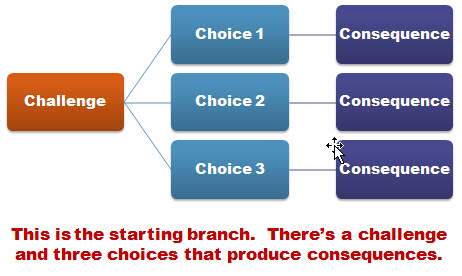1. Specifying target groups:
for each project, you should describe the target group in terms of age and proficiency.
Suggested limits:
scenario - 11+, with enough reading skills
IWB - almost any age + proficiency, though with young learners it would be a pretty hard work to prepare enough material on practicing e.g. basic colours
WebQuest - 15+, to apply enough analytical and evaluational skills
_________________________________________________
Why to use branchig scenarios?
_________________________________________________
While writing the scenario, define the following:
1. Target group - age, proficiency
2. Task - what the class should do, identifying the final outcome and product
3. Aims and objectives: what the class will learn in these fields:
- factual knowledge
- language (vocabulary, reading skills...)
- communicative skills
- social skills
Make a list of keywords to help the class read and understand.
Computers skills and specifics:
create a correct, logical text
write the whole scenario into a single text file first
add illustrations and graphics to support reading with undestanding
Evaluation criteria:
Creativity
The applied reading skills
Ethical and informational dimensions
Aesthetics
____________________________________
Creating scenarios in gomo (cloud-based elearning authoring tool, paid, 21days free trial)
Creating scenarios in Twine (free)
TWINE FAQ (ref from Twine Guide - see the link below) :
Creating links:
Most of the time, you'll be linking from one passage to another. The easiest way to do this is to put the name of the passage you're linking to in between two square brackets, [[like this]]. This will turn the passage name into a clickable link.
However, you may also want to have the text shown on the page be different from the passage name. For example, you might have two ways to reach a passage, or you may not want to give away the name of the destination. In these cases, you can write this:
- [[Open the cage door->Devoured by Lions]]
- [[Devoured by Lions<-open cage="" div="" door="" the="">
- [[Open the cage door|Devoured by Lions]]
In these examples, the clickable text will say “Open the cage door,” but the link will lead to a passage named
Devoured by Lions. Any of these formats will work; use whichever is the easiest to remember.Inserting html:
If you'd like to add HTML to your story – for example, some text you have customized, or you have some code to embed a resource like a YouTube video – you can add it directly to your passage's text. It will displayed exactly as you've entered it.
Inserting images:
Once you know what your image's URL is, having it display in your story is as simple as entering the correct HTML code to show up:
<img src="the URL of your image" width="500" height="300" alt="Two foxes">
The width and height part of the code control the size of your image on the page. If you leave them off, then it will display the image in the dimensions as you saved it.
If you are using relative links for your multimedia, you will need to publish your story to the correct location on your computer so that the references point to the right place. If you have an image tag whose source property is “myimage.jpeg”, for example, then your published file must be placed in the same folder as the file myimage.jpeg.
https://twinery.org/wiki/twine2:where_your_stories_are_saved
The best thing to do to avoid these problems is to regularly archive your work with the Archive link on the right sidebar of the story list. This saves all of your stories to a file on your computer that can then be restored with the Import link on the same page.
Publishing:
you'll need to publish your story using the Publish to File option in the story menu, and then post the resulting file to a web site.
_____________________________
Live examples of scenarios used in elearning:
https://elearningindustry.com/branching-scenario-elearning-5-killer-examples
https://www.elucidat.com/blog/branching-elearning-examples/
Scenario structure - Simulation map use (youtube)
See Cathy Moore's blog to find out about the practical use of scenarios.
Examples of scenarios:
http://sunil-rao.com/wp-content/uploads/Inner-Vision.swf
http://www.worldwarfighter.com/hajikamal/activity/
https://community.articulate.com/e-learning-examples/storyline-what-to-do-when-workplace-violence-happens
Twine to download
HELP for TWINE
Twine2Guide
More at
http://blog.cathy-moore.com/2011/07/sample-branching-scenario-cool-tool/
http://blog.cathy-moore.com/2010/05/elearning-example-branching-scenario/


